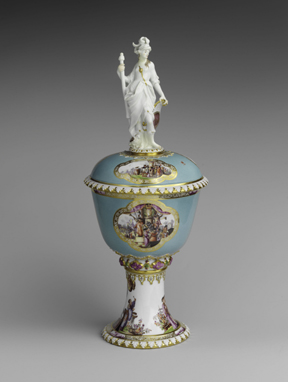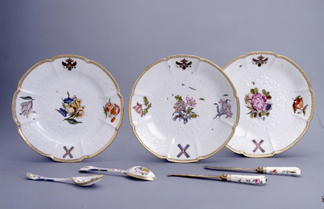
(845) 246-6944 ·
info@ArtTimesJournal.com
Fragile Diplomacy: Meissen Porcelain for European Courts
 Standing cup with figure of Minerva on the cover Meissen porcelain, 1735 Metropolitan Museum of Art |
By LAURIE SPIEGEL
ART
TIMES December 2007
Asia had been producing porcelain since the eighth century.
By the mid 16th century Asian porcelain appeared in some
royal collections, but the formula was a well-guarded secret. Alchemists
throughout Europe attempted to replicate this elusive material. It wasn’t
until 1710 at the court of August II (1670-1733), elector of Saxony
and king of Poland, that the formula for hard–paste porcelain
was discovered. The result was the first porcelain factory in Europe,
the court-owned Meissen “manufactory” in Dresden. Here was a product
that could be cast, carved and painted in infinite variety. The earliest
designs were copies of the Asian designs. Underglaze blue soon gave
way to polychrome and gilt. Porcelain was treasured because it was unique.
Decorative elements could be personalized (such as coats of arms,
for example). Large showpieces, full toilette and tea services were
sent in customized leather boxes. There was a “wow factor” when opening
the boxes. Why is porcelain still treasured and often used for gifts?
It may no longer be unique, but it is still beautiful.
 Flat plate, two deep plates, and flatware from the “St. Andrew” service, 1744–45. Meissen porcelain; silver-gilt knife blades. Plates after models by Johann Friedrich Eberlein; spoons and grips for knives: after models by Johann Gottlieb Ehder. Knife blades made in St. Petersburg in the second half of the 18th century. The State Hermitage Museum, St. Petersburg |
There are over 300 objects in the exhibit organized
by the country for which the pieces were made. Items are on loan from
institutions and private collections in this country and abroad. There
are exhibition-related educational programs and an illustrated catalogue
available with scholarly essays including a chapter on the politics
behind the diplomatic gifts. The exhibition will continue until February
11, 2008.
For further information contact The Bard Graduate Center
212 501-3011 BGC.BARD.EDU